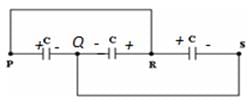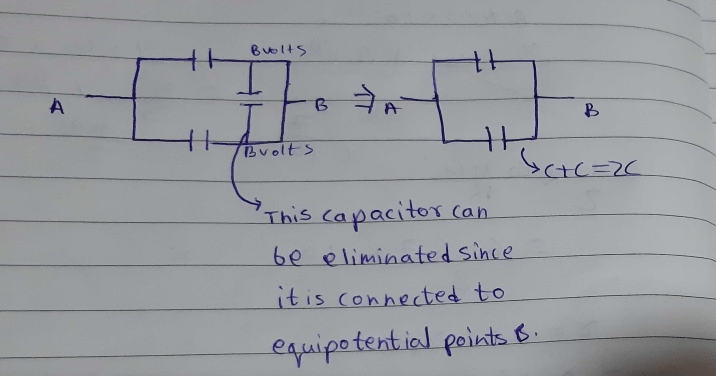All questions of Electrostatic Potential & Capacitance for JAMB Exam
The amount of work done in moving a charge from one point to another along an equipotential line or surface charge is- a)Zero
- b)Infinity
- c)One
- d)Two
Correct answer is option 'A'. Can you explain this answer?
|
|
Om Desai answered |
Which of the following is a non polar dielectric?- a)Water
- b)Alcohol
- c)HCl
- d)Benzene
Correct answer is option 'D'. Can you explain this answer?
|
|
Riya Banerjee answered |
What will be the effect on capacitance, if the distance between the parallel plates reduced to one-third of its original value?- a)decrease by a factor 3
- b)increase by a factor 3
- c)increase by a factor 3/2
- d)increase by a factor ½
Correct answer is option 'B'. Can you explain this answer?
|
|
Preeti Khanna answered |
Hence,C1/C2=d2/d1=(d/3)d=3
C2=3C1
Work done in carrying 2C charge in a circular path of radius 2m around a charge of 10C is- a)6.67J
- b)60J
- c)Zero
- d)15J
Correct answer is option 'C'. Can you explain this answer?
|
|
Suresh Iyer answered |
It is a well-known fact that W=qdv.
Here dV is the change in overall potential. In the circular orbit of r potential at each point is similar.
Most significantly, the value of r is 3.
The value of dv=0 and hence W=q0=0.
Electric field intensity at point ‘B’ due to a point charge ‘Q’ kept at a point ‘A’ is 12 NC-1 and the electric potential at a point ‘B’ due to same charge is 6 JC-1. The distance between AB is- a)2 m
- b)1.5 m
- c)1 m
- d)0.5 m
Correct answer is option 'D'. Can you explain this answer?
|
|
Nandini Patel answered |
As shown in the figure below, an ellipsoidal cavity is carved within a perfect conductor. A positive charge Q is placed at the centre of the cavity. If points A and b are shown on the cavity surface (see figure), then which among the following choices is correct?
- a)Potential at A = Potential at B
- b)Charge density at A = Charge density at B
- c)Electric field near A = Electric field near B
- d)Total electric flux at the surface of the cavity = zero
Correct answer is option 'A'. Can you explain this answer?
|
|
Om Desai answered |
we know that conductor is an equipotential surface, so potential will be the same at A and B.
As charge density, σ∝1/r, then charge density is different at A and B.
The electrostatic potential energy between two charges q1 and q2 separated by a distance by r is given by- a)

- b)

- c)

- d)

Correct answer is option 'D'. Can you explain this answer?

|
Khushi Mittal answered |
If 100 J of work has to be done in moving an electric charge of 4C from a place where potential is -5 V to another place, where potential is V volt. The value of V is- a)15 V
- b)20 V
- c)25 V
- d)10 V
Correct answer is option 'B'. Can you explain this answer?
|
|
Suresh Iyer answered |
W=q0x[vfinal-vinitial ]
100=4x[v-(-5)]
v+5=25
v=20V
Can you explain the answer of this question below:Equal charges are given to two spheres of different radii. The potential will
- A:
be equal on both the spheres
- B:
be more on the smaller sphere
- C:
be more on the bigger sphere
- D:
depend on the material of the sphere
The answer is b.
Equal charges are given to two spheres of different radii. The potential will
be equal on both the spheres
be more on the smaller sphere
be more on the bigger sphere
depend on the material of the sphere

|
Husna answered |
A hollow metal sphere of radius 5cm is charged so that the potential on its surface is 10V. The potential at a distance of 2cm from the centre of the sphere is- a)4V
- b)zero
- c)10/3V
- d)10V
Correct answer is option 'D'. Can you explain this answer?

|
Ayush Joshi answered |
Two capacitors of 20 μƒ and 30 μƒ are connected in series to a battery of 40V. Calculate charge on each capacitor.- a)480 C
- b)478 C
- c)450 C
- d)500 C
Correct answer is option 'A'. Can you explain this answer?
|
|
Nikita Singh answered |
Here is a combination of three identical capacitors. If resultant capacitance is 1 μƒ, calculate capacitance of each capacitor.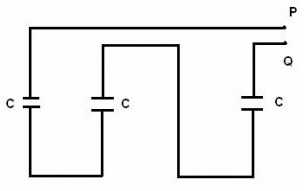
- a)6 μƒ
- b)3 μƒ
- c)4 μƒ
- d)2 μƒ
Correct answer is option 'B'. Can you explain this answer?
|
|
Lavanya Menon answered |
C(effective) = C/3 = 1
When two capacitors C1 and C2 are connected in series and parallel, their equivalent capacitances comes out to be 3 μƒ and 16 μƒ respectively. Calculate values of C1 and C2.- a)4μƒ and 12μƒ
- b)6μƒ and 10μƒ
- c)4μƒ and 10μƒ
- d)6μƒ and 12μƒ
Correct answer is option 'A'. Can you explain this answer?

|
Anonymous answered |
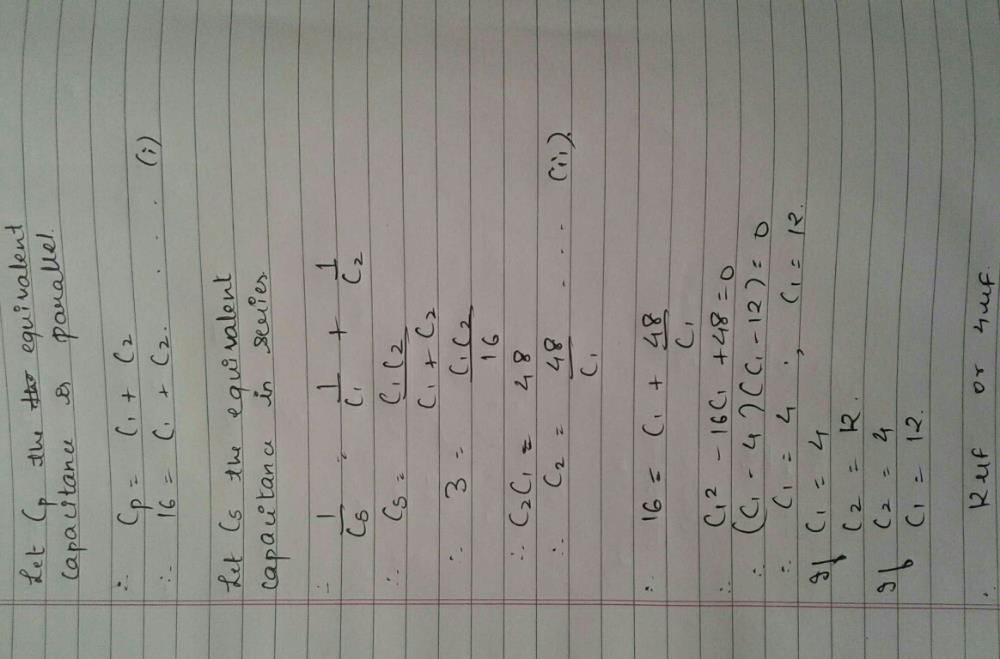
Can you explain the answer of this question below:It requires 4 J of work to move a charge of 20 C from point A to point B, separated by a distance of 0.2 cm. The potential difference between A and B in volts
- A:
0.2
- B:
16
- C:
5
- D:
80
The answer is a.
It requires 4 J of work to move a charge of 20 C from point A to point B, separated by a distance of 0.2 cm. The potential difference between A and B in volts
0.2
16
5
80

|
Mayank Singh answered |
A hollow metal sphere of radius 10 cm is charged such that the potential on its surface is 80 volt. The potential at the centre of the sphere is- a)8 volt
- b)zero
- c)800 volt
- d)80 volt
Correct answer is option 'D'. Can you explain this answer?

|
Sunidhi Pandey answered |
Can you explain the answer of this question below:In a parallel plate capacitor the potential difference of 150 V is maintained between the plates. If distance between the plates is 6 mm, what will be the electric field at points A and B?
- A:
2.5×103
- B:
2.5×104
- C:
2.5×105
- D:
3.5×104
The answer is b.
In a parallel plate capacitor the potential difference of 150 V is maintained between the plates. If distance between the plates is 6 mm, what will be the electric field at points A and B?
2.5×103
2.5×104
2.5×105
3.5×104
|
|
Om Desai answered |
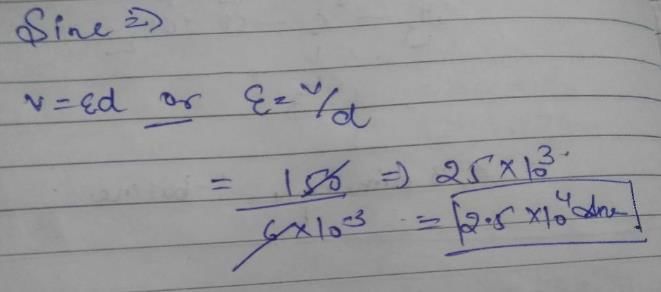
μμf is also called?- a)nanofarad
- b)microfarad
- c)picofarad
- d)fermifarad
Correct answer is option 'C'. Can you explain this answer?
|
|
Arghya answered |
The distance between the plates of a capacitor is d. What will be the new capacitance if a metal plate of thickness d/2 is introduced between the plates without touching them- a)it will be thrice of its initial value
- b)it will be double of its initial value
- c)remains the same
- d)it will be half of its initial value
Correct answer is option 'B'. Can you explain this answer?
|
|
Nisha Patel answered |
Capacitance of a capacitor:
The capacitance of a capacitor is given by the equation:
C = εA/d
where C is the capacitance, ε is the permittivity of the medium between the plates, A is the area of the plates, and d is the distance between the plates.
Effect of introducing a metal plate:
When a metal plate of thickness d/2 is introduced between the plates without touching them, the distance between the plates decreases by d/2. This means that the new distance between the plates is d/2.
New capacitance:
Using the equation for capacitance, we can calculate the new capacitance as:
C' = εA/(d/2)
C' = 2εA/d
The new capacitance is double the initial capacitance. Therefore, the correct answer is option B, "it will be double of its initial value."
Electric potential is- a)scalar and dimensionless
- b)vector and dimensionless
- c)scalar with dimension
- d)vector with dimension
Correct answer is option 'C'. Can you explain this answer?
|
|
Pooja Mehta answered |
Consider a solid cube made up of insulating material having a uniform volume charge density. Assuming the electrostatic potential to be zero at infinity, the ratio of the potential at a corner of the cube to that at the centre will be - a)1:1
- b)1:2
- c)1:4
- d)1:8
Correct answer is option 'B'. Can you explain this answer?
|
|
Sanaya Kumar answered |

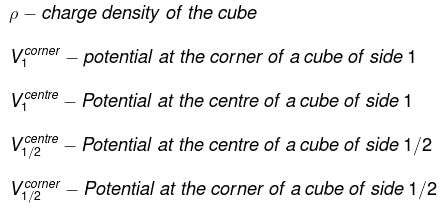


Because of the centre of the larger cube lies at a corner of the eight smaller cubes of which it is made
therefore,

Find the equivalent capacitance of the combination.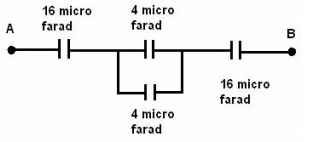
- a)16/3 μƒ
- b)16 μƒ
- c)19.0 μƒ
- d)8 μƒ
Correct answer is option 'C'. Can you explain this answer?

|
Kumari Sakshi answered |
Can you explain the answer of this question below:The potential energy of a system containing only one point charge is
- A:
Zero
- B:
Infinity
- C:
Nonzero finite
- D:
None of the above
The answer is a.
The potential energy of a system containing only one point charge is
Zero
Infinity
Nonzero finite
None of the above

|
.mie. answered |
Electric field at the surface of a charged conductor is proportional to- a)Surface charge density
- b)Volume of the sphere
- c)Volume charge density
- d)Area of the sphere
Correct answer is option 'A'. Can you explain this answer?

|
Ciel Knowledge answered |
We clearly see that the electric field is perpendicular to surface charge density (σ).
In bringing an electron towards another electron, the electrostatic potential energy of the system- a)becomes zero
- b)decreases
- c)remains same
- d)increases
Correct answer is option 'D'. Can you explain this answer?
|
|
Nandini Patel answered |
when two capacitors are put in series, the equivalent capacitance is - a)the reciprocal of the capacitances
- b)smaller than both capacitances
- c)the sum of the capacitances
- d)the product of the capacitances
Correct answer is option 'B'. Can you explain this answer?
|
|
Sreemoyee Sengupta answered |
When two capacitors are put in series, the equivalent capacitance is smaller than both capacitances.
Why is this so? Let's look at the equation for capacitance in series:
1/Ceq = 1/C1 + 1/C2
Where Ceq is the equivalent capacitance and C1 and C2 are the capacitances of the individual capacitors. From this equation, we can see that the sum of the reciprocals of the capacitances is equal to the reciprocal of the equivalent capacitance.
Now, let's consider what happens when we put two capacitors in series. In this case, the capacitors share the same charge, so the voltage across each capacitor is different. This means that the capacitances are not simply added together, but rather combine in a way that reduces the overall capacitance.
To see why this is the case, let's take a simple example. Suppose we have two capacitors, each with a capacitance of 1 microfarad. If we put these capacitors in series, the equivalent capacitance is:
1/Ceq = 1/1 + 1/1 = 1/2
Ceq = 2 microfarads
As we can see, the equivalent capacitance is smaller than the capacitance of either capacitor alone. This is because the capacitors effectively "cancel out" some of each other's capacitance due to the shared charge and differing voltages.
Overall, when two capacitors are put in series, the equivalent capacitance is smaller than both capacitances because the capacitors "cancel out" some of each other's capacitance.
Two metallic spheres of radii 1 cm and 3 cm are given charges of (-1 x 10-2 C) and 5 x 10-2 C , respectively. If these are connected by a conducting wire, the final charge on the bigger sphere is:
- a)2 x 10-2 C
- b)3 x 10-2 C
- c)4 x 10-2 C
- d)1 x 10-2 C
Correct answer is option 'B'. Can you explain this answer?
|
|
Rajeev Saxena answered |
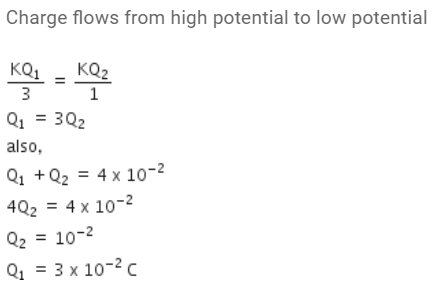
What is the direction of the lines of force at any point on the equipotential surface?- a)Parallel to it
- b)Perpendicular to it.
- c)Inclined at 45 degrees
- d)None of the above
Correct answer is option 'B'. Can you explain this answer?
|
|
Anjali Iyer answered |
If a unit charge is taken from one part to another part over an equipotential surface, then what is the change in electrostatic potential energy of the charge?- a)10 J
- b)100 J
- c)1 J
- d)0 J
Correct answer is option 'D'. Can you explain this answer?

|
Utsav Srivastava answered |
Find the band gap energy when a light of wavelength 1240nm is incident on it.- a)1eV
- b)2eV
- c)3eV
- d)4eV
Correct answer is option 'A'. Can you explain this answer?
|
|
Khushi Singh answered |
Work done in placing a charge of 8 x 10-18 C on a condenser of capacity 100 microfarad is- a)4 x 10-10 J
- b)32 x 10-32 J
- c)16 x 10-32 J
- d)3.1 x 10-26 J
Correct answer is 'B'. Can you explain this answer?
|
|
Naina Bansal answered |

The potential energy of a system containing only one point charge is
- a)Zero
- b)Infinity
- c)Non zero finite
- d)None of the above
Correct answer is option 'A'. Can you explain this answer?
|
|
Manoj Chauhan answered |
Potential energy is defined as the work done by an external force in bringing a system from infinity to its position. Hence, the potential energy of a system containing only one point charge is given by -
U = qV
where, q is the charge of the point charge and V is the potential at its position.
Now, let's consider the two cases -
Case 1: When the point charge is at infinity
At infinity, the potential is zero as the electric field due to a point charge decreases as we move away from it. Hence, the potential energy of the system containing only one point charge at infinity is zero.
U = qV = q x 0 = 0
Case 2: When the point charge is at a finite distance from infinity
In this case, the potential energy of the system will be non-zero finite as the potential at the position of the point charge will be non-zero.
U = qV ≠ 0
Conclusion:
Hence, the correct answer is option 'A' i.e. zero as the potential energy of a system containing only one point charge is zero when the point charge is at infinity.
If the potential difference between the plates of a capacitor is increased by 0.1%, the energy stored in the capacitor increases by very nearly- a)0.1%
- b)0.144%
- c)0.11%
- d)0.2%
Correct answer is option 'D'. Can you explain this answer?
|
|
Amar Shah answered |
To understand why the correct answer is option 'D', let's consider the equation for the energy stored in a capacitor:
**Energy (E) = 1/2 * C * V^2**
where E is the energy, C is the capacitance, and V is the potential difference (voltage) across the capacitor plates.
According to the question, the potential difference between the plates of the capacitor is increased by 0.1%. Let the initial potential difference be V1 and the increased potential difference be V2.
**Change in Potential Difference = (V2 - V1) = 0.1% of V1**
Using this information, we can write the new potential difference as:
**V2 = V1 + (0.1/100) * V1 = V1 + 0.001 * V1 = (1 + 0.001) * V1 = 1.001 * V1**
Next, we need to find the change in energy stored in the capacitor. Let the initial energy be E1 and the increased energy be E2.
**Change in Energy = (E2 - E1) = ?**
Using the equation for energy, we can write the new energy as:
**E2 = 1/2 * C * V2^2 = 1/2 * C * (1.001 * V1)^2 = 1/2 * C * (1.001^2) * V1^2**
Now, let's calculate the change in energy:
**Change in Energy = (E2 - E1) = 1/2 * C * (1.001^2) * V1^2 - 1/2 * C * V1^2**
Simplifying this expression:
**Change in Energy = 1/2 * C * V1^2 * (1.001^2 - 1) = 1/2 * C * V1^2 * (1.001^2 - 1)**
To find the percentage increase in energy, we need to divide the change in energy by the initial energy and multiply by 100. Let's calculate:
**Percentage Increase in Energy = (Change in Energy / E1) * 100**
Substituting the expression for change in energy:
**Percentage Increase in Energy = [1/2 * C * V1^2 * (1.001^2 - 1)] / [1/2 * C * V1^2] * 100**
Simplifying this expression:
**Percentage Increase in Energy = (1.001^2 - 1) * 100 = (1.001 * 1.001 - 1) * 100 = (1.002001 - 1) * 100 = 0.2001 * 100 = 0.2%**
Therefore, the energy stored in the capacitor increases by approximately 0.2% when the potential difference between the plates is increased by 0.1%. Hence, the correct answer is option 'D' (0.2%).
A hollow metal sphere of radius 20 cm is charged such that the potential on its surface is 120 Volt. The potential at the centre of the sphere is- a)80 V
- b)6 V
- c)120 V
- d)Zero
Correct answer is 'C'. Can you explain this answer?
|
|
Anjana Sharma answered |
Two charged conducting spheres of radii a and b are connected to each other by a wire. The ratio of electric fields at the surfaces of two spheres is- a)a/b
- b)b/a
- c)a2/b2
- d)b2/a2
Correct answer is option 'B'. Can you explain this answer?
|
|
Mira Joshi answered |
The charge flows from the sphere at higher potential to the other at lower potential, till their potentials becomes equal.
After sharing, the charges on two spheres would be
q1/q2 = C1V/C2V…(i)
Also C1C2 = ab…(ii)
From (i) q1/q2 = a/b
Ratio of surface charge on the two spheres
σ1/σ2 = q1/4πa2⋅4πb2/q2 = q1/q2⋅b2/a2 = b/a(using(ii)
∴ The ratio of electric fields at the surfaces of two spheres E1/E2 = σ1/σ2 = b/a
The amount of work done in moving a unit positive charge through distance of 10 cm on an equipotential surface is- a)100 joule
- b)10 cm
- c)1/10 cm
- d)Zero
Correct answer is option 'D'. Can you explain this answer?

|
Anupam Singh answered |
If two spheres of different radii have equal charge, then the potential will be- a)dependent on nature of material of the spheres.
- b)more on smaller sphere
- c)more on bigger sphere
- d)equal on both spheres
Correct answer is option 'B'. Can you explain this answer?

|
Sushil Kumar answered |
Since potential is inversely proportional to radius, the smaller radius will have higher potential and vice versa.
The capacitor preferred for high-frequency circuit is - a)Air capacitor
- b)Mica capacitor
- c)Electrolytic capacitor
- d)None of the above
Correct answer is option 'B'. Can you explain this answer?

|
Sushil Kumar answered |
A charge q = 1.0 C moves distance of 1.5 m in the direction of a uniform electric field E of magnitude 2.0 N/C. Find its change in electrostatic potential energy.- a)2 J
- b)3 J
- c)4 J
- d)1 J
Correct answer is option 'B'. Can you explain this answer?

|
Anchal Maurya answered |
Chapter doubts & questions for Electrostatic Potential & Capacitance - Physics for JAMB 2025 is part of JAMB exam preparation. The chapters have been prepared according to the JAMB exam syllabus. The Chapter doubts & questions, notes, tests & MCQs are made for JAMB 2025 Exam. Find important definitions, questions, notes, meanings, examples, exercises, MCQs and online tests here.
Physics for JAMB
259 videos|253 docs|230 tests
|

